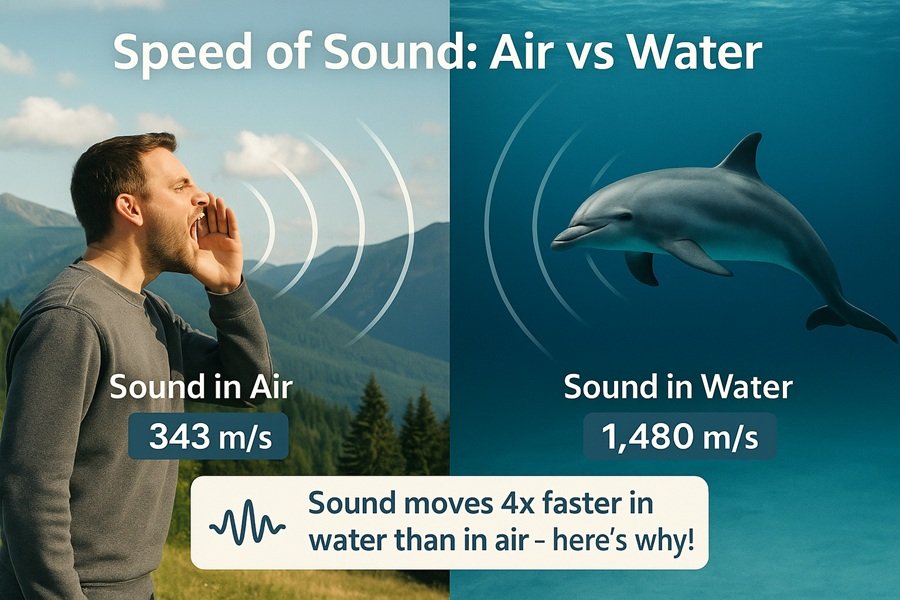
We often associate sound with what we hear in the air around us—voices, music, traffic, or birdsong. But sound can travel through any medium: air, water, solids—even steel. A common question arises: Does sound travel faster in water or in air?
The answer is: sound travels faster in water than in air. In fact, it’s more than four times faster. But why? To understand this, we need to explore how sound works, how different media affect its speed, and what this means in real-life situations.
What Is Sound, Really?
Sound is a mechanical wave that travels through a medium by the vibration of particles. It needs a material (like air, water, or metal) to move through—it cannot travel through a vacuum like light does.
Sound Characteristics:
- Type: Longitudinal wave (particles vibrate parallel to wave direction)
- Requires: A medium (solid, liquid, or gas)
- Speed: Depends on the medium’s density and elasticity
Comparing Speeds: Water vs Air
Let’s look at the average speeds of sound in different media:
| Medium | Speed of Sound (Approx.) |
|---|---|
| Air (20°C) | 343 m/s |
| Water (25°C) | 1,480 m/s |
| Steel | 5,960 m/s |
As the table shows, sound travels over 4 times faster in water than in air, and it’s even faster in solids like steel. The key lies in the molecular structure of these materials.
Why Does Sound Travel Faster in Water?
1. Particle Proximity
Water molecules are more closely packed than air molecules. Since sound relies on vibrating molecules to pass energy along, this close packing allows vibrations to transfer more rapidly.
2. Elasticity
Water is more elastic than air—it can return to its original shape more efficiently after being compressed. This enhances wave propagation speed.
3. Density Factor
Though water is denser than air, its higher elasticity has a greater influence, allowing sound to travel faster. In denser but highly elastic materials (like steel), sound travels even faster.
Real-Life Examples & Applications
🐋 Underwater Communication by Whales
Whales and dolphins use sound to communicate across hundreds of kilometers underwater—something impossible in air due to slower speed and greater dissipation.
🎧 Sonar Technology
Submarines and ships use SONAR (Sound Navigation and Ranging) to map the seafloor, detect objects, and measure ocean depth—all relying on the speed of sound in water.
👂 Hearing Underwater
If you try to speak or listen underwater, the sound may seem muffled or distorted. That’s because:
- Human ears aren’t designed to hear efficiently in water.
- Water conducts sound to the bones of the skull rather than through the ear canal.
What About Temperature and Salinity?
Both temperature and salinity affect sound speed in water:
- Warmer water = faster sound speed
- Higher salinity = faster sound speed
Similarly, in air, warmer temperatures also increase sound speed slightly.
Sound Travel in Other Media
To put it into perspective:
| Medium | Molecule Type | Sound Speed (m/s) |
|---|---|---|
| Air | Gas | 343 |
| Water | Liquid | 1,480 |
| Wood | Solid | 3,900 |
| Steel | Solid | 5,960 |
As you move from gas → liquid → solid, the speed of sound increases, assuming the material is sufficiently elastic.
Explore:
- Do sharks have bones?
- Which Planet Can Float on Water?
- What’s the Biggest Organ in the Human Body?
- Do Fingers Have Muscles?
- Which Country Has the Most Pyramids? Explore Pyramid Capital of the World
Conclusion: Sound Travels Faster in Water
Yes, sound travels significantly faster in water than in air—thanks to the denser, more elastic structure of water molecules. This has important implications in marine biology, sonar systems, underwater exploration, and physics education.
So the next time you drop a stone in a lake and hear the “plunk,” remember: that sound reached nearby fish much faster than it reached your ears through the air!






